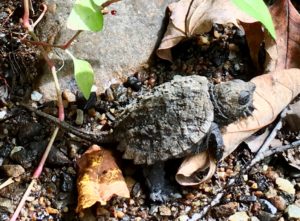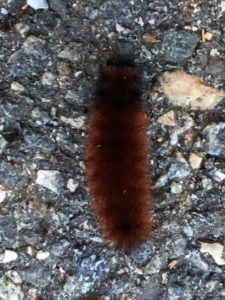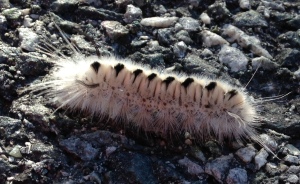Hello fellow readers,
This time of year, on morning walks with Miss Ellie, I come across woolly bear caterpillars (Pyrrharctia isabella) and can’t help but help them along. Just as I pick them up, they curl into balls of fur. After ten or so saves, I consider just letting them be, but imagining them squished on the road is too much to bear. They’re scrambling for a place to overwinter in decaying plant debris. The odd thing is the side of the road they came from has as many plants.
Woolly bears seen in the fall are the second generation of caterpillars that emerge in August. The first generations come in May. In the spring, they’ll surface and feed on plants such as birch, maple, clover, aster, herbs, and grass, then spin a cocoon. In two weeks, an Isabella Tiger Moth emerges. Eventually, the females lay eggs, and the cycle continues.
You likely know about the legend of woolly bears predicting winter. The narrower the reddish-brown band, the harsher the weather. They say there’s no scientific proof, and from my observation, their band fashions run the gambit. From the classic black ends equally sized with a reddish-brown middle to all brown or all black. Even an all-blonde fuzzy crossed the road. Then there are those with only one black band, a popular style this season.
Admittedly there’s a contradiction about my kindness in helping woolly bears. I’ve come across other critters roadside, such as the white fuzzy Hickory Tussock caterpillars (Lophocampa caryae) that I didn’t help cross the road. They are adorable, with longish spikes of fur jutting beyond their white coat, fashioning a row of black spots. The thing is, they can cause a nasty rash that may require medical attention. (Here’s a link to a previous column on the subject). I feel bad not helping the furry fellas, though.
A few weeks ago, dozens of worms took to the road during a rainy spell. I didn’t try to save them. Partly because so many slithery critters seemed daunting, but mostly because of the slime factor versus cute and fuzzy. They say worms take advantage of wetness, which allows them to move far more quickly than through the soil.
I’ve helped more than the furry cross the road, though. Recently I came across a baby snapping turtle. Quarter sized. The little guy was sluggish, perhaps dehydrated. I carried him to the brook running beneath the road. He quickly roused and raced to the water finding shelter under a heart-shaped stone. Helping him especially lifted me. My soulful twin, Bill, had an affinity for turtles. Garden Dilemmas? Askmarystone@gmail.com

Recently I came across a baby snapping turtle. Quarter sized. The little guy was sluggish, perhaps dehydrated.
Link to a related story you’ll enjoy Turtle Island, also featured in Episode 19 of the Garden Dilemmas Podcast:
Column Updated 11/3/22





Dear Mary,
I liked the caterpillars and their stripes. The turtle was handsome , but not my favorite!
Hope to see you today at the party!
Love, Mom J.